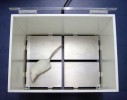Authors
Kinga Saat, Anna Wiêckowska, Krzysztof Wiêckowski, Georg C. Höfner et al.
Lab
Jagiellonian University, Medical College, Kraków, Poland
Journal
Pharmacological Reports, Polish Academy of Sciences
Abstract
Background: g-Aminobutanoic acid (GABA) is the principal inhibitory neurotransmitter in the mammalian central nervous system. The identification and subsequent development of the GABA transport inhibitors which enhance the GABA-ergic transmission has shown the important role that GABA transporters play in the control of numerous functions of the nervous system. Compounds which inhibit GABA uptake are used as antiepileptic drugs (tiagabine – a selective GAT1 inhibitor), they are also being investigated for other indications, including treatment of psychosis, general anxiety, sleep disorders, drug addiction or acute and chronic pain.
Methods: In this paper, the synthesis of 2-substituted-4-(1,3-dioxoisoindolin-2-ylo)-butanamides and 2-substituted-4-minobutanoic acids derivatives is described. These compounds were tested in vitro for their ability to inhibit GABA uptake. The inhibitory potency towards murine plasma membrane GABA transporters (mGAT1-4) was performed as [3H]GABA uptake assay based on stably transfected HEK cells. Compound 18, which demonstrated the highest affinity for mGAT1-4 (pIC50 ranged from 4.42 for mGAT1 to 5.07 for mGAT3), was additionally investigated in several behavioral tests in mice.
Results: Compound 18 increased the locomotor activity (14–38%) and had anxiolytic-like properties in the four-plate test (ED50 = 9.3 mg/kg). It did not show analgesic activity in acute pain model, namely the hot plate test, however, it was antinociceptive in the acetic acid-induced writhing test (ED50 = 15.3 mg/kg) and in the formalin model of tonic pain. In the latter assay, it diminished nocifensive behavior in both phases and in the first (neurogenic) phase of this test the obtained ED50 value (5.3 mg/kg) was similar to morphine (3.0 mg/kg).
Conclusion: Compound 18 exhibited significant anxiolytic-like properties and was antinociceptive in some models of pain in mice. Moreover, it did not impair animals’ motor coordination in the chimney test. Some of the described pharmacological activities of compound 18 can be partly explained based on its affinity for plasma membrane GABA transporters.
BIOSEB Instruments Used:
Aron Test or Four Plates Test (LE830)

 Douleur - Allodynie/Hyperalgésie Thermique
Douleur - Allodynie/Hyperalgésie Thermique Douleur - Spontanée - Déficit de Posture
Douleur - Spontanée - Déficit de Posture Douleur - Allodynie/Hyperalgésie Mécanique
Douleur - Allodynie/Hyperalgésie Mécanique Apprentissage/Mémoire - Attention - Addiction
Apprentissage/Mémoire - Attention - Addiction Physiologie & Recherche Respiratoire
Physiologie & Recherche Respiratoire
 Douleur
Douleur Métabolisme
Métabolisme Système moteur
Système moteur Neurodégénérescence
Neurodégénérescence Thématiques transversales
Thématiques transversales Système musculaire
Système musculaire Functions de motricité générale
Functions de motricité générale Troubles de l'humeur
Troubles de l'humeur Other disorders
Other disorders Joints
Joints Système Nerveux Central (SNC)
Système Nerveux Central (SNC)  Système sensoriel
Système sensoriel
